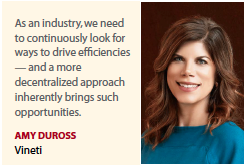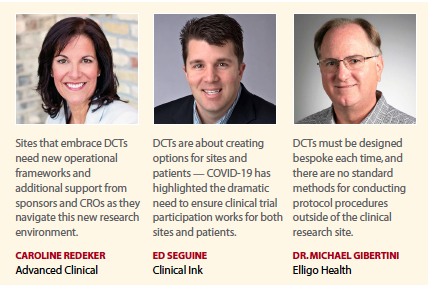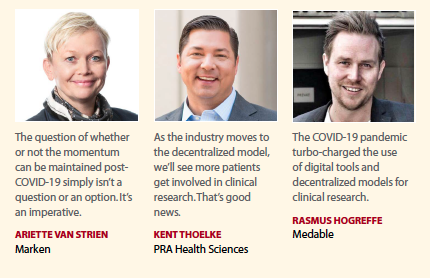When it comes to decentralizing clinical trials, what was long a cracked door has been flung open wide by the COVID-19 pandemic.
With COVID-19 sparking major upheaval in clinical trial execution, sponsors, CROs, and other supporters of drug development have been forced to adopt tools long used in decentralized clinical trials (DCTs) to safely monitor patients in their homes rather than on site. And in doing so, they’re realizing the many benefits of such practices.
For that reason, Rasmus Hogreffe, VP of decentralized trial innovation at Medable, believes pharma will continue this pace of adoption of DCTs even as life returns to normal post-pandemic.“The COVID-19 pandemic turbo-charged the use of digital tools and decentralized models for clinical research," Mr. Hogreffe says. “Even investigator sites, which have been stuck between the ‘fear of missing  out’ and the fear of the unknown, will continue to cautiously push forward with DCTs as they see patients receiving better care. Sites may not make the switch to DCTs overnight, but they will slowly let go of their concerns as they see the impact that a decentralized approach has on patient care."
out’ and the fear of the unknown, will continue to cautiously push forward with DCTs as they see patients receiving better care. Sites may not make the switch to DCTs overnight, but they will slowly let go of their concerns as they see the impact that a decentralized approach has on patient care."
“I absolutely think the momentum towards decentralization can be maintained post-COVID-19, although initially, I do think you will see a trend to get back to tight centralized control and higher-touch interactions in a trial setting — if only ‘because we can’ and our population will have been craving those for so long," says Amy DuRoss, co-founder and CEO at Vineti. “Still, as an industry, we need to continuously look for ways to drive efficiencies — and a more decentralized approach inherently brings such opportunities."
Zach Hales, product manager – ClinCard at Greenphire, calls the shift “the beginning of the future of clinical research" and believes the momentum will continue post-COVID, though he foresees the proportion of in-person versus virtual visits fluctuating based on the pandemic and other dynamics. Greenphire conducted a survey of sponsors and CROs on the impact of COVID-19 on research, and 84% said they were actively seeking to increase the use of technology to better support decentralized clinical trials. “Sponsors and CROs had been driving in this direction prior to COVID-19," he notes. “They wanted to offer this level of care, and the global pandemic helped spur the adoption of tools to enable patient centricity. In the end, these tools will yield more data and further insight into the patient experience, and site adoption that will only continue to drive innovation."
 “We anticipate the widely adopted and accepted changes to clinical trials will continue to be used long after the catalyst of the pandemic wanes — because that’s what patients deserve," says Roger Smith, CEO of Signant Health. He adds that Signant Health has teamed with industry leaders and more than 20 signatory companies and organizations to launch the #NoGoingBack movement at www.nogoingback.health, which asks people involved with clinical trials to pledge to preserve the progress made under the pandemic.
“We anticipate the widely adopted and accepted changes to clinical trials will continue to be used long after the catalyst of the pandemic wanes — because that’s what patients deserve," says Roger Smith, CEO of Signant Health. He adds that Signant Health has teamed with industry leaders and more than 20 signatory companies and organizations to launch the #NoGoingBack movement at www.nogoingback.health, which asks people involved with clinical trials to pledge to preserve the progress made under the pandemic.
“As an industry, each and every one of us plays a part in ensuring that decentralized trials continue to take hold and find increasing traction and success," says Ariette Van Strien, president of Marken. “The question of whether or not the momentum can be maintained post-COVID-19 simply isn’t a question or an option. It’s an imperative."
Caroline Redeker, senior VP, corporate development at Advanced Clinical, thinks some changes need to take place before this shift becomes a long-term trend.
“The pandemic forced sites to embrace elements of DCTs as a stopgap measure to keep patients safe and trials in compliance," Ms. Redeker says. “However, not all sites will choose to work this way in the future. Sites that embrace DCTs need new operational frameworks and additional support from sponsors and CROs as they navigate this new research environment."
“Ultimately DCT/hybrid trials are about creating options for sites and patients — COVID-19 has simply highlighted the dramatic need to ensure clinical trial participation works for both sites and patients," says Ed Seguine, CEO of Clinical Ink. “However, simply acknowledging the need for flexibility will not solve the problem, which is that existing systems were not built for the type of flexibility that DCT/hybrid studies require — let alone the integration of multiple brittle systems such as EDC, ePRO/eCOA, and IRT. Moreover, the speed and urgency of dealing with COVID-19 challenges should become the norm — e.g., the ability to implement in less than 30 days routinely, instead of through Herculean effort."
Staying Safe, Staying Compliant
 Experts agree that DCTs provide many benefits to both patient and sponsor. Mr. Hogreffe notes DCTs allow patients to stay safely in their homes while having physician-monitored access to potentially life-altering new therapies.
Experts agree that DCTs provide many benefits to both patient and sponsor. Mr. Hogreffe notes DCTs allow patients to stay safely in their homes while having physician-monitored access to potentially life-altering new therapies.
“And, because patients’ health is surveilled continuously using wearables, electronic diaries, virtual check-ins, and other tools, they receive premier care," he adds. “Further, sites can respond to questions or issues in real time and engage directly with patients more often. Real-world data from daily, in-the-moment patient accounts, before memory-muddled experiences are recounted at the next in-person visit weeks later, will also improve data quality and could lead to better outcomes."
DCTs also increase diversity by allowing groups that traditionally do not join clinical trials because of financial and logistical burdens to participate. Richard Davies, VP, solution expert, at CluePoints, points out that DCTs help recruitment by removing perceived burden and inconvenience. “This brings diversity in recruitment by being able to access a wider population of willing participants and ultimately drives patient retention because it’s simply easier to participate from the comfort of your own home," he says.
Mr. Davies says DCTs also allow for a greater proportion of data to be collected digitally at the source, making it available earlier and quelling the impulse to implement minimal-value quality control processes like source data verification.
“Using telemedicine and patient home visits by mobile healthcare professionals to supplement or replace traditional site visits also introduces more communication pathways with the patient, which can support patient compliance and facilitate collection of ad-hoc data such as adverse events," he says.
“We are already seeing and anticipating continued positive impact in the following areas: patient centricity, patient diversity, recruitment and retention, and reduction in source data verification," says Sapna Hornyak, president and CEO of Avania. “We are also seeing an increase in longitudinal data collection from patients because of the use of mobile technologies and additional capacity at investigative sites, which is a direct result of the reduction in the time, cost, and operational burden of managing patients at the site."
Geoffrey Gill, president of Shimmer Americas, says DCTs increase remote monitoring through wearable sensors, which hold the promise of replacing occasional, often subjective, in-clinic measures with continuous objective measures. “By increasing accuracy and reducing noise, these measures have the potential to increase trial success rates, reduce the number of participants required, shorten trials, and improve safety," he says.
“With greater trial access across all demographics, study data will be more comprehensive providing greater insight into developing new treatments that improve the health of a more diverse population," Mr. Hogreffe says. “The improvements in trial speed, too, will drive more novel drugs to patients faster and for less cost."
Better Care Through Decentralization
Even with the switch to more virtual means of monitoring and data collection, experts believe DCTs offer better patient care than traditional clinical trials. “Any opportunity to build compliance and a sense of ownership in outcomes among patients is going to drive efficiencies and higher quality care," Ms. DuRoss says.
Ms. Hornyak agrees that DCTs offer a more patient-centric approach and have the potential to connect patients to trials that were previously inaccessible to them because of their location giving them new care options that may not be locally or regionally available.
 “DCTs can drastically reduce the scheduling and travel burdens on patients allowing them to participate in clinical studies from the comfort of their home," she says. “This is an especially important consideration for patients with mobility issues or for those who do not reside near a clinical trial site. This flexibility will enhance patient engagement, which is an essential aspect of clinical trials."
“DCTs can drastically reduce the scheduling and travel burdens on patients allowing them to participate in clinical studies from the comfort of their home," she says. “This is an especially important consideration for patients with mobility issues or for those who do not reside near a clinical trial site. This flexibility will enhance patient engagement, which is an essential aspect of clinical trials."
Krystle Buntemeyer, president of SCORR Marketing, notes that the current trend merges two clinical research components that have been around for a long time: decentralized trials and clinical research as a care option.
“COVID-19’s impact has brought them together in a more immediate way," Ms. Buntemeyer says. “Patients’ reluctance to go to their doctor’s office, along with travel restrictions, meant decentralized trials moved into the spotlight as a viable option. Paired with the technology component that is now more readily available than a decade ago — using eSource/DDC/EDC, personal devices, and more — it’s made mobile health a reality. Now more than ever, decentralized trials have given clinical research as a care option an evolutionary push."
According to Ms. Van Strien, using clinical trials as a treatment option can offer advantages that exceed those of standard healthcare, but one of the biggest barriers is patient awareness, since the majority of the population doesn’t even think to consider them.
“Another very real challenge is the logistical commitments required for patients to come to a site — taking the time, traveling, the disruption to daily life," she says. “Decentralized trials remove that hurdle by tapping into rapidly evolving technology like televisits, eClinical software, wearable data capture devices, and more. Also, by tapping direct-to-patient supply chain solutions and home healthcare options, complex logistics are further mitigated.
“When home health workers can administer drugs, collect biological samples, perform study compliance checks, and more all on patients’ own time, in their own homes, using cutting-edge scientific treatment — the benefits are indisputable," she adds.
“Decentralized trials remove barriers like cost, cultural resistance to change, and data integrity, while also facilitating patient responsibilities and reduced physician involvement," Ms. Buntemeyer says. “The big question is whether the increased adoption of decentralized trials is temporary, or the beginning of a permanent, longer-term evolution that will continue to support clinical research as a viable care option."
Facing the Barriers
Even with adoption rates climbing, DCTs aren’t without their challenges. Michael Gibertini, Ph.D., chief development officer at Elligo Health, notes that while the idea of the DCT has existed for years, implementation has been slow because of doubts as to whether the technology and processes can control data integrity or monitor patient safety.
“DCTs must be designed bespoke each time, and there are no standard methods for conducting protocol procedures outside of the clinical research site," Mr. Gibertini says. “A second barrier to DCT acceptance is the fact that clinical research can only rarely dispense with the clinic. Fortunately, it is possible, through established networks of physicians and automated workflow, to allow research to follow the patient into their own doctor’s office and clinic.
Conceptualizing the basic unit of research as the doctor-patient dyad and using technology to centrally curate the experience — while keeping a close eye on safety and data integrity — is the next evolution of DCTs."
Mr. Smith believes fully digitally enabled sites are the future of clinical research. “The use of interconnected software systems by patients and sites — particularly for evidence generation — offers new levels of data quality and stewardship," he says. “The pathway to efficient and high-quality evidence generation is being forged by software stacks that sit inside research sites, usually in the cloud and surrounded by expertise to add value beyond the raw information."
Mr. Hogreffe believes the biggest barrier to widespread adoption of DCTs is study complexity. “The regulatory requirements for consenting and distribution of drugs to patients and delivering care and services at home are still evolving, too," he says. “In addition, Internet connectivity is irregular in some geographies and patient comfort with digital and wearable devices is improving but still unpredictable.
“Bottom line is there will always be situations that require in-person care, such as to administer certain intravenous chemotherapy treatments for cancer patients, and will be better suited for a hybrid approach," he continues. “Flexibility is key, and fundamental to decentralized trial platforms."
“There will always be components of certain clinical trials that demand tight centralized control — the trick will be in the determination of what can be shifted into a more decentralized management setting," Ms. DuRoss says. “Also of concern are cybersecurity and privacy, the latter of which has been relaxed in some COVID-19 trials. Additionally, in the United States, many of the individual states’ practice of medicine laws will have to be adjusted in order to accommodate more DCTs going forward."
Mr. Davies notes that in certain geographical areas access to investigators that are licensed to treat patients across different regional states already exists, making it easy to access a community of investigators that can manage a geographically disparate patient population.
“It’s difficult to have a conversation with any sponsor regarding DCTs without someone commenting on a perceived need for further regulatory guidance on their implementation from a regulatory perspective," he says. “Some regulators are more communicative than others, which opens a perception that implementing a DCT in certain geographies may ultimately be riskier than others."
According to Kent Thoelke, executive VP and chief scientific officer of PRA Health Sciences, pharma and biotech companies have to be willing to depart from a long history and experience with traditional trial design paradigms.
“For most sponsors, it’s likely that hybrid approaches will be used initially by deploying some digital components or replacing some in-person visits with virtual visits utilizing mobile/connected and telehealth platforms, as well as local providers and home healthcare nurses," Mr. Thoelke says. “As the industry moves to the decentralized model, we’ll see more patients get involved in clinical research. That’s good news for our industry and for overall patient health and well-being."
Ms. Van Strien notes that as trials shifted to decentralized or hybrid models, the vulnerability of the global supply chain was exposed.
“Although easing of COVID-19 restrictions will allow a certain level of localized manufacturing and shipment, the global supply chain is in need of close evaluation," she says. “Removal of remaining barriers is necessary to eliminate a fragile supply chain from impeding an enduring, sustained move to hybrid or decentralized trials on a larger, more permanent scale. Hybrid and decentralized trials are here to stay — we need to ensure that every step of the process is as high-functioning and ‘unbreakable’ as it can possibly be."(PV)

















